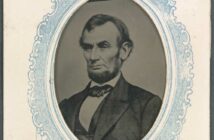By Sue Boardman & Elle Lamboy | Photo Courtesy of Adams County Historical Society
When the Civil War arrived in this small south-central Pennsylvania town, it not only ravaged the fields but also the town’s businesses, homes, and establishments. Townspeople found their churches transformed into hospitals, shops stripped for supplies, and homes and hotels turned into headquarters.
George Spangler and his family experienced this type of civilian devastation—an outcome of the Battle of Gettysburg that is often overlooked but critical to understanding Gettysburg’s history and character.
George Spangler lived on his farm, which rests at 488 Blacksmith Shop Road, with his wife Elizabeth and their four children. Prior to July 1-3, 1863, when the Battle of Gettysburg raged through the town, the property was a thriving subsistence farm with livestock including horses, milk cows, sheep, and swine and plentiful crops like corn, wheat, potatoes, and oats. The Spanglers also had orchards and a bountiful garden on the property.
During the battle, the serene yet productive home and farm were totally transformed into a place of chaos and crisis for thousands of people including soldiers, surgeons, caregivers, volunteers, and the Spangler family. The property was converted into an ammunition staging area for the Union army and a field hospital for the 2nd Division of the 11th Union Army Corps; it later became the main hospital for all wounded of that corps. Reportedly 1,800 Union soldiers and 100 Confederate soldiers were treated at the Spangler property by at least seven federal surgeons.
There are several structures on the property that were overtaken during the battle. A large Pennsylvania bank barn was the dominant building on the farmstead. It provided shelter for livestock on the lower level and housed equipment and stored the hay, straw, and grain on the upper level. During the battle, both levels housed wounded soldiers recovering from surgery. Medical procedures occurred in the barn as well as the surrounding area. Soldiers and surgeons occupied the same land that inhabited livestock just hours before.
The summer kitchen was a one-and-a-half story fieldstone and wood frame building that stood away from the farmhouse so the family could cook meals in the hot summer months without heating the home or spreading accidental fires. Many experts believe that Confederate Gen. Lewis Armistead died in the summer kitchen as a result of the wounds he suffered during Pickett’s Charge. Pvt. Justus M. Silliman of the 17th Connecticut Volunteer Infantry, who saw Armistead at the George Spangler Farm before he died, recounted that Armistead “lay in the kitchen on the night of July 3.” It is likely he was referring to the summer kitchen and not the farmhouse kitchen because it was common practice to keep high-ranking officers isolated from lower-ranking soldiers.
The farmhouse was a two-and-a-half story fieldstone structure where the family lived before the battle. During the battle, the house became the headquarters for the medical operation team, as well as a makeshift hospital. There was also a smokehouse on the property, which was used to preserve meats. The soldiers likely ransacked the smokehouse of its supply during the battle.
Following the Civil War, the Spanglers’ farm and home were in shambles. In addition to occupying the structures, the medical team and troops took fence rails for fuel, crops and hay were used to feed soldiers and horses, and lumber and shingles became hospital furniture, makeshift beds, and coffins.
Not only were the Spanglers faced with a destroyed farm and homestead, but their property also served as a gravesite for nearly 200 soldiers. In the months following the battle, loved ones came to retrieve the bodies of the deceased from the Spanglers’ property from shallow graves.
The battle’s impact didn’t end on July 3. Despite reporting more than $3,000 in losses, the Spanglers only received a meager $90 from the federal government in compensation fees. They not only witnessed lives being lost; they also lost their livelihood.
Today, the barn, smokehouse, and summer kitchen are preserved to their 1863 appearances and are open to the public during the summer months. For more information, visit www.gettysburgfoundation.org.
Sue Boardman is a licensed battlefield guide, Cyclorama historian, author, and the leadership program director for Gettysburg Foundation. Elle Lamboy is the director of membership and philanthropic communications for Gettysburg Foundation, a nonprofit educational organization working with the National Park Service to enhance preservation and understanding of the heritage of Gettysburg and its national parks. Gettysburg Foundation also owns and operates Gettysburg National Military Park Museum and Visitor Center. Visit www check out here.gettysburgfoundation.org.





4 Comments
Enjoyed Reading this as my Mother s maiden name was Kathryn Mae Spangler, She was a direct relative of George Spangler. When I was a youngster my parents took me to see the property, I can still clearly rember the Spring ( Spangler Spring ) where the Union and Confederate Soldiers would go to get water duringm the battle.
At the time I was there the spring was still as it was during the battle. I understand that now the spring has been protected with a concrete barrier of some sort.
Thank you for this short article.
What are the names of George and Elizabeth’s children? I believe this family is related to ours, according to genealogy records.
So sad to hear about the devastation. I’d like to know more about what happened to the family afterwards. Did they move? Were they able to restore the farm? I believe the Spanglers were a fairly large family in the area; what about the relatives? Were they able to help out?
Hi,
We have a picture of a George Spangler in his uniform who was in the 20th Calvary during the Civil War. Is it possible he is related to your family? If he is, I will gladly send the picture to you.